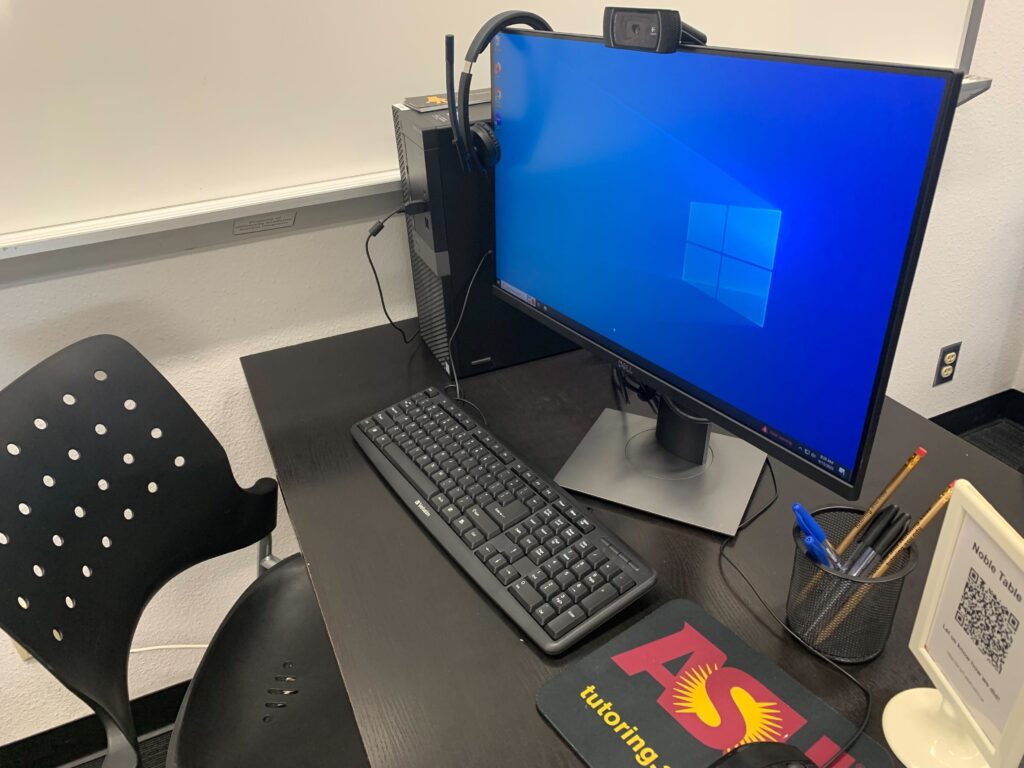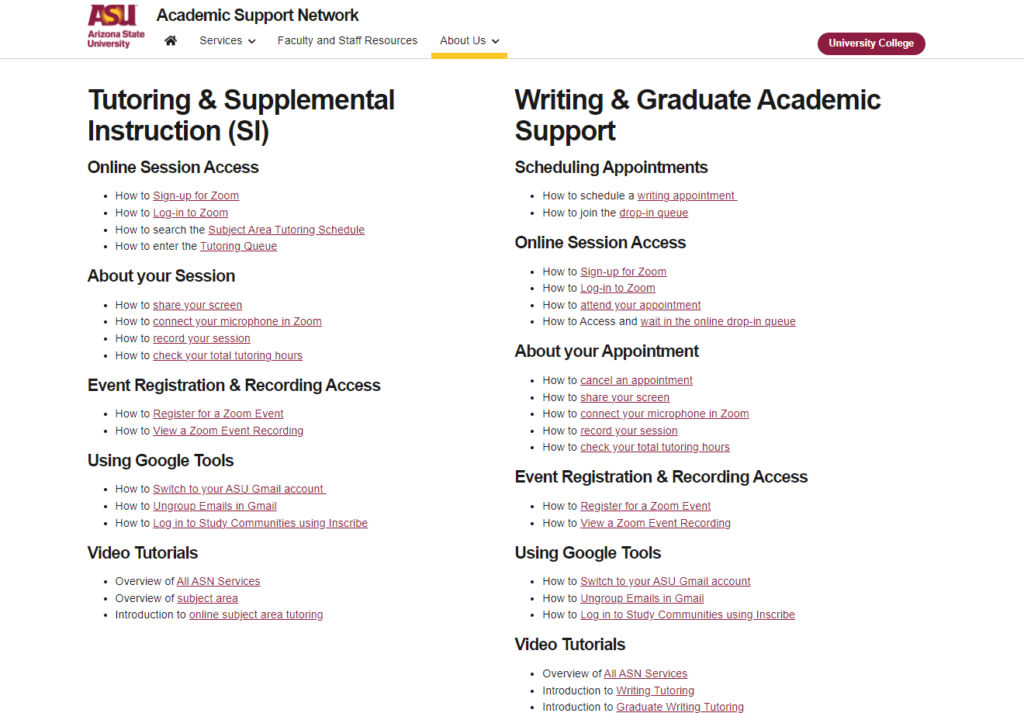By Daniella Peinado, Dava Newell, Lisa Diethelm, and Jessica Jones
Supporting students’ writing online has been a topic of conversation in writing centers for decades. Muriel Harris discussed incorporating technology into writing centers in 2000, and in 2009, Neaderhiser and Wolfe reviewed ways writing centers were using new technology tools to support writing centers. The Academic Support Network (ASN) at Arizona State University (ASU) has developed a dual-modality tutoring model which taught us how to identify our core goals for supporting student’s writing to then use available technologies to adapt and meet those goals.
Background
Since 2013, ASN has been providing online writing services synchronously through one-on-one appointments and drop-ins to support the 60,000+ students enrolled in ASU Online programs. During that time, writing tutors were hired to conduct only in-person appointments or only online appointments; there was no switching between modalities. Additionally, the online-only writing center had what many felt were limited hours of operation given the global student audience; Sundays-Thursdays between 3pm and 10pm.
Feeling like a change was needed to expand what online writing options were available to the campus community, discussions began in February 2020 on how to expand online services to be offered in a dual-modality starting in Fall 2020, meaning that all writing tutors would also be available to connect with students online or in-person. After going completely online with writing tutoring services from March 2020 to August 2020 due to the pandemic, we then had to consider how to best provide options for students to access services both in-person or online, since many more students and tutors would be opting to not come to campus when in-person classes resumed in the Fall of 2020.
Driving Questions
Previously, when scheduling appointments, students had to first pick either an in-person or online center, which would then show them only that specific center’s availability. Predicting that we would have a continued high demand for online appointments in addition to a need for in-person options, we wanted to implement a process to allow the most available options for students, regardless of whether they wanted to attend in-person or online. This prompted us to define driving questions to implement services in a dual-modality.
We defined dual-modality as having an appointment system where tutors could meet with a student at any given time either in-person at a writing center or online, and allow the student to make that modality choice. This would allow more writing tutors to be available for appointments with students either in-person or online and help increase appointment unitization. Following that, we needed to identify ASN’s goals on how it can help all learners succeed in this accelerated timeline. This was a new process, so the next step was for ASN to find an approach to best explain the process to the writing tutors and the students we support.

ASN’s goal has always been for students to have a similar experience regardless of how they decide to visit our writing centers. In the summer of 2020, we had to think about:
- What would be the standardized process for all our in-person writing centers across ASU campuses and our online center?
- How could Zoom’s features best be leveraged for our dual-modality approach?
- What kind of physical technology did we need to purchase for our writing centers to allow for dual-modality?
Based on our driving questions, we started implementing a process that would allow for an effective dual-modality learning environment.
Process Implementation

We first needed to set the expectations for what dual-modality would look like for students and student staff in order to ensure the transition was as seamless as possible. This meant thinking about not only what was desired out of the model, but also what was practical for day-to-day operations. We needed to think through what both students and student staff should expect, which was born out of the most realistic and ideal brainstorms that we had given the resources available to us.
With regard to resources, we had to find ways to use technology to our advantage. Our institution already had an enterprise account with Zoom set up and accessible to students, and ASN began using Zoom for online tutoring in May 2019. We were fortunate to have our institution agree to provide funding for us to obtain items such as headsets and webcams, that greatly enhance the experience of dual-modality not only for students, but also for our student staff.

With the new expectations and technology sorted, our next step was to think about how we’d train our staff, not only on how to use the technology, but also on how to embrace dual-modality. We had to think about what this looked like on a human level:
- How do our student staff interact with students on Zoom and in person?
- How do we optimize the camera features to ensure the layout is welcoming online and in person?
- How does a student in either modality ask for help?
These questions guided us to a standardized way of operating that resulted in a bank of How To Guides for student staff and students to refer to as needed post-training and throughout the semester. With the How To Guides, students are able to increase their technological literacy, which was one of the main barriers of concern with regard to the implementation of dual-modality. It’s important to note that our How To Guides and Procedures are living documents. As we continue to see the needs of our student population change, as well as technology updates, we adapt as needed. This allows us to create effective workflows that support students and our student staff.

Current/Ongoing Challenges
Even with our adaptable How To Guides and training programs, students and their needs are ever-changing. In order to continue to provide essential writing support, it is crucial that ASN continues to accept and brainstorm solutions for the current and ongoing challenges being presently faced by student staff, student users, and others who may utilize our writing services. For the last three years, ASN writing tutors have tutored both in person and online, using the technology at the writing tutor stations to meet with students online through Zoom or in person at the physical centers in the Phoenix Metro area.
While the technology we use makes our services accessible in a dual-modality, it still has limitations. Whenever our technology does not work or load properly, for example, student staff have to troubleshoot the issue while balancing their responsibilities – from meeting with students to updating our records. To account for technological issues, professional staff had to create a process that student staff could follow when they needed it. We developed a backup sign in document that is updated every semester so that student staff can record the details of their sessions and meet with their student users at their scheduled time.
Our dual-modality presents additional challenges for our student users. While we implement the dual-modality, we still need to consider what resources students can access. Some students may not have access to the technology that is needed for our dual-modality, or they may not have the physical means to get to an in-person center. To account for this, we have to also consider the different barriers students may face and prepare possible solutions that our student staff and users can rely on during a session. For example, if a student comes to an online session but is having issues with their Zoom microphone, how do we provide them alternatives so that they still can connect to our services the best they can? In the past, we have trained our student staff to use all available tools in Zoom such as the chat and Zoom whiteboard so that they can communicate with students in more than one way.
The examples we cited here do not cover every kind of challenge ASN’s writing centers have faced, but each challenge we do face continues to teach us how we can adapt our dual-modality so that we consistently meet the needs of our students.

Next Steps & Discussion
As we live dual-modality in the ASN writing centers, we continue to see new opportunities and challenges to address. These challenges may also be applicable to other writing center administrators as they define their core goals for supporting student writing while leveraging available technology.
- Online ASU students are seeking support from across the globe in different time zones.
- Local ASU students have a variety of unique schedules that do not always align with ASN hours of operation.
Given that we cannot be open 24/7, ASN started working to create online study hubs to help address these challenges. These are online communities using InScribe where students can post questions at any time, and the ASU community (which includes tutors, faculty, and other students) can respond. Tutors are also adding writing resources for common questions they are seeing on a weekly basis. The newest technology of today can potentially be archaic six months from now; technology will make the needs of all writing centers ever-changing. In order to embrace technology in ASN’s writing centers, we had to define our purpose; we encourage you to do the same as you reflect on ways to leverage technology in your writing centers.
Works Cited
Harris, Muriel. “Making Up Tomorrow’s Agenda and Shopping Lists Today: Preparing for Future Technologies in Writing Centers.” Taking Flight with OWLs: Examining Electronic Writing Center Work, edited by James A. Inman and Donna N. Sewell. Routledge, 2000, pp. 193–202.
Neaderhiser, Stephen, and Joanna Wolfe. “Between Technological Endorsement and Resistance: The State of Online Writing Centers.” The Writing Center Journal, vol. 29, no. 1, 2009, pp. 49–77.

Daniella Peinado recently started her career in higher education in the Fall of 2022. She currently works as a Program Coordinator for the Supplemental Instruction program that is part of Academic Support Network at Arizona State University. She enjoys being immersed in various learning centers, programs, and the educational support they offer.
Currently working as a Program Coordinator Senior supporting the Supplemental Instruction Program at Arizona State University, Dava Newell has experience managing tutoring centers, mentoring student staff, and collaborating interdepartmentally in order to advance university initiatives.


Lisa Diethelm works as the Coordinator Senior and supports the Writing and Graduate Writing Centers at Arizona State University. Currently, she supervisors the Online Graduate Writing Center. She has experience in mentoring writing and graduate writing tutors and curriculum development for writing workshops, ASN’s graduate writing camps, and writing tutoring training.
Jessica Jones has been working in Education professionally for 15 years in various positions in University Housing, Student Activities, and Academic Support. Currently, she is the EDGE Learning & Professional Development Specialist in Human Resources at The University of Arizona.


